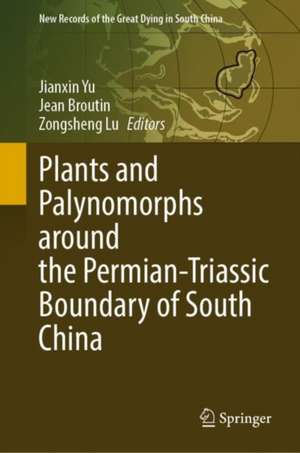Plants and Palynomorphs around the Permian-Triassic Boundary of South China: New Records of the Great Dying in South China
Editat de Jianxin Yu, Jean Broutin, Zongsheng Luen Limba Engleză Hardback – 9 aug 2022
| Toate formatele și edițiile | Preț | Express |
|---|---|---|
| Paperback (1) | 831.88 lei 38-44 zile | |
| Springer Nature Singapore – 10 aug 2023 | 831.88 lei 38-44 zile | |
| Hardback (1) | 1113.89 lei 3-5 săpt. | |
| Springer Nature Singapore – 9 aug 2022 | 1113.89 lei 3-5 săpt. |
Preț: 1113.89 lei
Preț vechi: 1358.41 lei
-18% Nou
Puncte Express: 1671
Preț estimativ în valută:
213.13€ • 222.55$ • 176.00£
213.13€ • 222.55$ • 176.00£
Carte disponibilă
Livrare economică 25 martie-08 aprilie
Preluare comenzi: 021 569.72.76
Specificații
ISBN-13: 9789811914911
ISBN-10: 9811914915
Pagini: 254
Ilustrații: XIV, 254 p. 63 illus., 38 illus. in color.
Dimensiuni: 155 x 235 mm
Greutate: 0.59 kg
Ediția:1st ed. 2022
Editura: Springer Nature Singapore
Colecția Springer
Seria New Records of the Great Dying in South China
Locul publicării:Singapore, Singapore
ISBN-10: 9811914915
Pagini: 254
Ilustrații: XIV, 254 p. 63 illus., 38 illus. in color.
Dimensiuni: 155 x 235 mm
Greutate: 0.59 kg
Ediția:1st ed. 2022
Editura: Springer Nature Singapore
Colecția Springer
Seria New Records of the Great Dying in South China
Locul publicării:Singapore, Singapore
Cuprins
Chapter 1 Literature Review.- Chapter 2 Stratigraphy of the studied sections.- Chapter 3 Materials and methods.- Chapter 4 Late Permian Changhsingian flora in varied palaeogeographic settings in South China .- Chapter 5 Early Triassic Induan flora in varied palaeogeographic settings in South China.- Chapter 6 Palynology across the Permian-Triassic Boundary in South China.- Chapter 7 Extinction Pattern and recovery of the Permian-Triassic Flora in South China.- Chapter 8 Plant and environment co-evolution in Permian-Triassic Transition.- Chapter 9 Systematic Palaeontology.- Chapter 10 Plant Fossils.- Chapter 11 Megaspores.- Chapter 12 Spore and Pollen Fossils.
Notă biografică
Professor Jianxin Yu works at the State Key Laboratory of Biogeology and Environmental Geology and School of Earth Sciences, China University of Geosciences, Wuhan, China. Her research interests involve the Permian–Triassic plants and palynomorphs, Mesozoic to Cenozoic palynomorphs and paleoclimatic evolution. She obtained her Ph.D. degrees at University Paris VI (Université Pierre et Marie Curie) and China University of Geosciences and has also worked at University Paris VI (Université Pierre et Marie Curie) as a visiting researcher. She has served as the chief scientist of several NSFC projects and has published more than 50 peer-reviewed scientific papers, covering Global and Planetary change, Earth Science Review, as well as Review of Paleobotany and Palynology.
Professor Jean Broutin works at History of the Earth (National Museum of natural History) and University Pierre & Marie Curie, where he was the head of the research team “Paleobotany and Paleoecology”. His research interests involve the late Paleozoic and Mesozoic plants, palynomorphs, taphonomy and paleoclimate. He has served as the chief scientist of several CNRS projects and other international competitive research grants. He has published more than 190 peer-reviewed scientific papers, covering Earth Science Review, Review of Paleobotany and Palynology, Journal of Asian Earth Sciences, as well as Palaeogeography, Palaeoclimatology and Palaeoecology.
Professor Zongsheng Lu works at the State Key Laboratory of Biogeology and Environmental Geology and School of Earth Sciences, China University of Geosciences, Wuhan, China. His research interests include the Triassic–Jurassic plants, trace fossils and sedimentary. He worked at Queensland University as a visiting scholar. He has served as the chief scientist of several NSFC projects and has published more than 45 peer-reviewed scientific papers.
Textul de pe ultima copertă
This book documents timely and systematically marvelous fossils (plants and sporopollen) related to the biggest mass extinction of the Permian–Triassic transition. Numerous beautiful pictures and comprehensive records on the plants of this unique and critical interval of geohistory are presented in this book. It greatly contributes to understanding of the Permian–Triassic plant diversity and evolution. For geologists, it is important to understand the Permian–Triassic crisis, and for students, it is attractive to learn about the plants’ response to palaeoclimatic changes.
Caracteristici
Provides numerous collections of the latest Permian–earliest Triassic plants and palynomorphs of South China Describes the latest Permian–earliest Triassic plants and palynomorphs and reviews some disputable species or genera Summarizes the evolutional stages of plants from the latest Permian–earliest Triassic globally Analyzes the causes/dynamics for changes/evolution of plants across the Permian–Triassic transition



